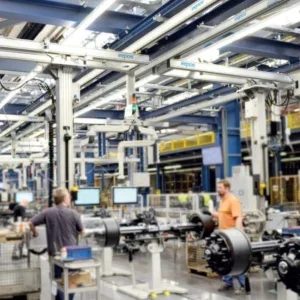“I’m happy in retirement and can reflect on a job well done, I was always conscious, especially in the later years of my career, that the company, and industry, must go on without me so I spent as much time as possible passing knowledge onto the next generation,” said de Kruijf.
Under the tutorship of Martinus B. van de Wetering, owner of Inter Product (IP), the Netherlands, Kruijf worked as a mechanical engineer. Prior to that he was at Stork, now a Fluor company, in Utrecht.
IP had 50 employees and did everything from purchasing, engineering, manufacturing, marketing, and sales. It was eventually bought by The Crosby Group.
“Martinus was my teacher. I learnt most things I know from him. At the time, there was no documented knowledge or means to study lifting clamps. Most things you learnt were in practice and the progression of the product sector was reliant on people like Martinus to be creative and see the solution through the lifting problem. This isn’t something you can learn in school. That being the case, I started to understand that we were largely responsible for taking our industry forward,” added de Kruijf. “To be called Mr. IP is flattering but it’s always been a team effort.”
Kees Gillesse, product development engineer, The Crosby Group, says 75% of the products in its lifting clamps catalog has been at least in part designed by de Kruijf.
CrosbyIP-branded clamps are The Crosby Group’s range of vertical lifting clamps, but the catalog has expanded to include hundreds of others, including IPU (universal; any direction), IPH (horizontal).
One that stands out for de Kruijf is his first—the IPPE clamp, for lifting and transporting non-bendable sheet mental in a horizontal position. The jaw opening can be easily adjusted for the height of the bundle or plate. Magnets in the foot-plate allow one person to operate multiple clamps simultaneously.
“When I started developing lifting clamps,” he recalls, “All calculations were done with an arithmetic ruler and the drawings drafted with a pencil. When the dimensions were good, I would put them in ink. Later came the calculator, before drawings were made by computer; we all know about today’s computer-aided design [CAD] capability. Modern technology enables us to develop different working load limits of the same model clamp much easier.”
The IPGNS, however, is de Kruijf’s favourite clamp—a non-marring product up to 6t capacity, now available with either steel or stainless-steel clamping plates, allowing the clamp to be used in wet conditions.
“It isn’t necessarily the most standout clamp on its own,” he says, “But it went on to inspire many other clamps and its features are seen in multiple models. Today’s range of vertical, horizontal, and pipe lifting clamps, for example, offer a myriad of features specifically designed for the demands of wind energy applications. A standout feature of CrosbyIP-branded standard and bespoke clamps is a non-marring camsegment.”
When handling steel plates with lifting clamps, the clamping camsegment and pivot usually leave an indentation in the material surface—known as marring. Because of the high standards in the wind energy industry, these indentations must be ground away from the surface. This rework costs time and money. By reducing the height of the teeth of the camsegment and pivot, the pitch between the teeth can be decreased and more teeth can be in contact with the material surface, reducing the depth of the indentations.
The last lifting clamp that de Kruijf worked on from start to finish was the IPTKA universal beam clamp, for hoisting, pulling, and positioning beams. It can be used as a temporary tackle point in side-loading applications. de Kruijf says it boasts side-loading capacity at 100% of the working load limit up to a 90-degree lifting angle. It is easy to close and open with a hinged body with self-locking device and available with a multi-purpose hoisting eye for tightening and hoisting.
Whether it be the IPPE, IPGNS, IPTKA, or another clamp altogether, “The user always drives the innovation,” de Kruijf says. “I used to interact one-on-one with the person who encountered the lifting or material handling problem. These days, channel partners also play an integral role as we look at the end-use application collectively and, if necessary, adapt one of the hundreds of clamps that we have already designed. But the principle is the same.”






